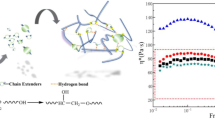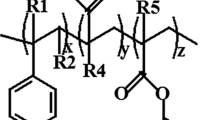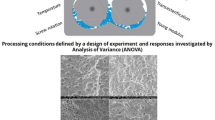Abstract
We investigated poly(butylene adipate-co-terephthalate) (PBAT), a biodegradable polymer, under the influence of a chain extender (a multifunctional epoxide oligomer, Joncryl ADR-4370S®, ADR) at different concentrations, and correlated their properties concerning the molecular interaction between the active sites of the structures. Several studies have used ADR in poly(lactic acid)-PBAT blends; however, the effect of ADR in terms of chemical and physical interaction with PBAT is not investigated in-depth, which can limit its applications. The chain extender is usually applied to improve the mechanical and thermal properties and PBAT resistance to thermal degradation. The developed materials were evaluated by high-resolution solid-state nuclear magnetic resonance (NMR), Fourier transform infrared spectroscopy (FTIR), mechanical and thermal properties, and rheological measurements. NMR and FTIR indicate an interaction between the carboxylic sites of PBAT and the epoxy sites of ADR. PBAT-2%ADR shows higher tensile properties, probably due to the hydrogen bonds and interactions of π–π nature between the materials; in this case, the ADR can act as a reinforcing agent. High contents of chain extender can change the nature of the interaction and influence the final properties of the polymer. The effect of this additive was found to be strongly dependent on the content used and the polymer processing. It was observed that ADR could act as an internal lubricant during processing (due to the low molecular weight of this additive), demonstrating the importance of processing parameters control.







Similar content being viewed by others
References
Li G, Shankar S, Rhim J, Oh B (2015) Effects of preparation method on properties of poly (butylene adipate-co-terephthalate) films. Food Sci Biotechnol 24:1679–1685
Wang X, Weng Y, Wang W, Huang Z, Wang YZ (2016) Modification of poly (propylene carbonate) with chain extender ADR-4368 to improve its thermal, barrier, and mechanical properties. Polym Test 54:301–307
Castro JG, Rodrigues BM, Ricci R, Costa MM, Ribeiro AFC, Marciano FR, Lobo AO (2016) Designing a novel nanocomposite for bone tissue engineering using electrospun conductive PBAT/polypyrrole as scaffold to direct nanohydroxyapatite electrodeposition. RSC Adv 6:32615–32623
Hu L, Du M, Zhang J (2018) Hemicellulose-based hydrogels present status and application prospects: a brief review. Open J For 8:15–28
Schneider J, Manjure S, Narayan R (2016) Reactive modification and compatibilization of poly(lactide) and poly(butylene adipate-co-terephthalate) blends with epoxy functionalized-poly(lactide) for blown film applications. J Appl Polym Sci 133:43310
Karsli NG (2015) A study on the fracture, mechanical and thermal properties of chain extended recycled poly(ethylene terephthalate). J Thermoplast Compos Mater 30:1157–1172
Wei D, Wang H, Xiao H, Zheng A, Yang Y (2015) Morphology and mechanical properties of poly(butylene adipate-co-terephthalate)/potato starch blends in the presence of synthesized reactive compatibilizer or modified poly(butylene adipate-co-terephthalate). Carbohydr Polym 123:275–282
Siyamak S, Ibrahim NA, Abdolmohammadi S, Yunus WMZBW, Rahman MZAB (2012) Enhancement of mechanical and thermal properties of oil palm empty fruit bunch fiber poly(butylene adipate-co-terephtalate) biocomposites by matrix esterification using succinic anhydride. Molecules 17:1969–1991
Costa ARM, Almeida TG, Silva SML, Carvalho LH, Canedo EL (2015) Chain extension in poly(butylene-adipate-terephthalate). Inline testing in a laboratory internal mixer. Polym Test 42:115–121
Cardoso LG, Pereira Santos JC, Camilloto GP, Miranda AL, Druzian JI, Guimarães AG (2017) Development of active films poly (butylene adipate-co-terephthalate)—PBAT incorporated with oregano essential oil and application in fish fillet preservation. Ind Crops Prod 108:388–397
Chaves RP, Fechine GJM (2016) Thermo stabilisation of poly (butylene adipate-co-terephthalate). Polimeros 26:102–105
Al-itry R, Lamnawar K, Maazouz A (2012) Improvement of thermal stability, rheological and mechanical properties of PLA, PBAT and their blends by reactive extrusion with functionalized epoxy. Polym Degrad Stab 97:1898–1914
Nunes ECD, Souza AG, Rosa DS (2019) Effect of the Joncryl® ADR compatibilizing agent in blends of poly(butylene adipate-co-terephthalate)/poly(lactic acid). Macromol Symp 383:1800035
Silva MVG, Decol M, Sena A, Marconcin JM, Mattoso LHC, Pachekoski WM, Becker D (2014) Influência da adição de extensor de cadeia nas propriedades do nanocompósito de pla/nanotubos de carbono. In: 21° CBECIMAT—Congresso Brasileiro de Engenharia e Ciência dos Materiais, pp 2665–2672.
Panaitescu DM, Vuluga Z, Ghiurea M, Iorga M, Nicolae C, Gabor R (2015) Influence of compatibilizing system on morphology, thermal and mechanical properties of high flow polypropylene reinforced with short hemp fibers. Compos Part B Eng 69:286–295
Cai Y, Lv J, Feng J (2013) Spectral characterization of four kinds of biodegradable plastics: poly (lactic acid), poly (butylenes adipate-co-terephthalate), poly (hydroxybutyrate-co-hydroxyvalerate) and poly (butylenes succinate) with FTIR and raman spectroscopy. J Polym Environ 21:108–114
Al-Itry R, Lamnawar K, Maazouz A, Bilon N, Combeaud C (2015) Effect of the simultaneous biaxial stretching on the structural and mechanical properties of PLA, PBAT and their blends at rubbery state. Eur Polym J 68:288–301
Abdelwahab MA, Taylor S, Misra M, Mohanty AK (2015) Thermo-mechanical characterization of bioblends from polylactide and poly(butylene adipate-co-terephthalate) and lignin. Macromol Mater Eng 300:299–311
Arruda LC, Magaton M, Bretas RES, Ueki MM (2015) Influence of chain extender on mechanical, thermal and morphological properties of blown films of PLA/PBAT blends. Polym Test 43:27–37
Clawson JS, Vogt FG, Brum J, Sisko J, Patience DB, Dai W, Sharpe S, Jones AD, Pham TN, Johnson MN, Copley RCP (2008) Formation and characterization of crystals containing a pleuromutilin derivative, succinic acid and water. Cryst Growth Des 8:4120–4131
Gagnebien D, Madec PJ, Maréchal E (1985) Synthesis of poly(sulphone-b-siloxane)s-I. Model study of the epoxy-phenol reaction in the melt. Eur Polym J21:273–287
Pinheiro IF, Morales AR, Mei LH (2014) Polymeric biocomposites of poly (butylene adipate-co-terephthalate) reinforced with natural Munguba fibers. Cellulose 21:4381–4391
Bastarrachea L, Dhawan S, Sablani SS, Mah JH, Kang DH, Zhang J, Tang J (2010) Biodegradable poly(Butylene adipate-co-terephthalate) films incorporated with nisin: characterization and effectiveness against Listeria innocua. J Food Sci 75:E215–E224
Muthuraj R, Misra M, Mohanty AK (2015) Hydrolytic degradation of biodegradable polyesters under simulated environmental conditions. J Appl Polym Sci 132:42189
Almeida TG, Neto JES, Costa ARM, Silva AS, Carvalho LH, Canedo EL (2016) Degradation during processing in poly(butylene adipate-co-terephthalate)/vegetal fiber compounds estimated by torque rheometry. Polym Test 55:204–211
Yang Z, Xin C, Mughal W, Li X, He Y (2018) High-melt-elasticity poly (ethylene terephthalate) produced by reactive extrusion with a multi-functional epoxide for foaming. J Appl Polym Sci 135:45805
Acknowledgements
The authors thank the Thiago Branquinho de Queiroz for the help with the NMR analysis, UFABC, REVALORES Strategic Unit, Capes (Code 001), CNPq (nº 306401/2013-4 and 305819/2017-8) and Multiuser Central Facilities (UFABC).
Author information
Authors and Affiliations
Corresponding author
Rights and permissions
About this article
Cite this article
de Souza, A.G., Nunes, E.C.D. & Rosa, D.S. Understanding the effect of chain extender on poly(butylene adipate-co-terephthalate) structure. Iran Polym J 28, 1035–1044 (2019). https://doi.org/10.1007/s13726-019-00764-w
Received:
Accepted:
Published:
Issue Date:
DOI: https://doi.org/10.1007/s13726-019-00764-w




